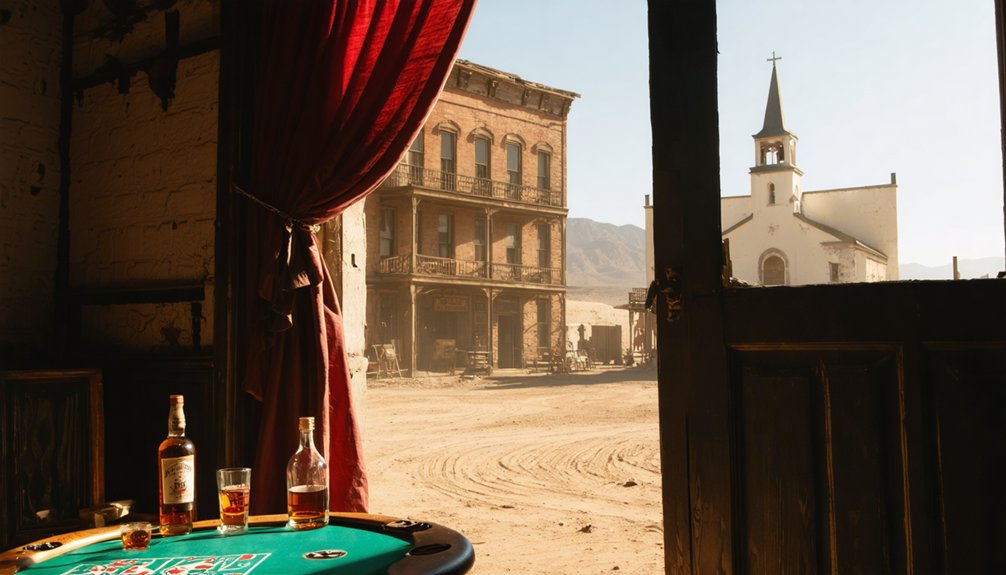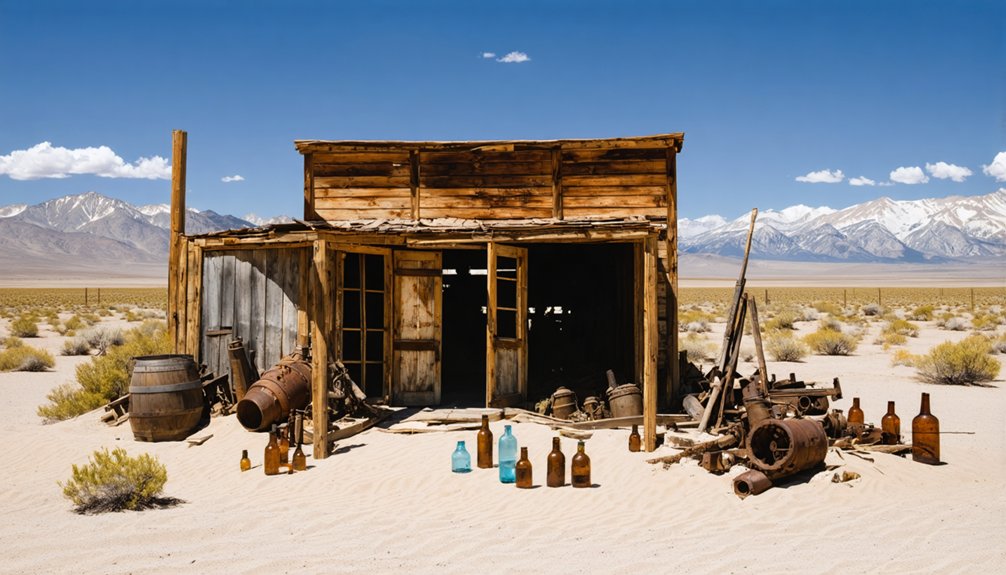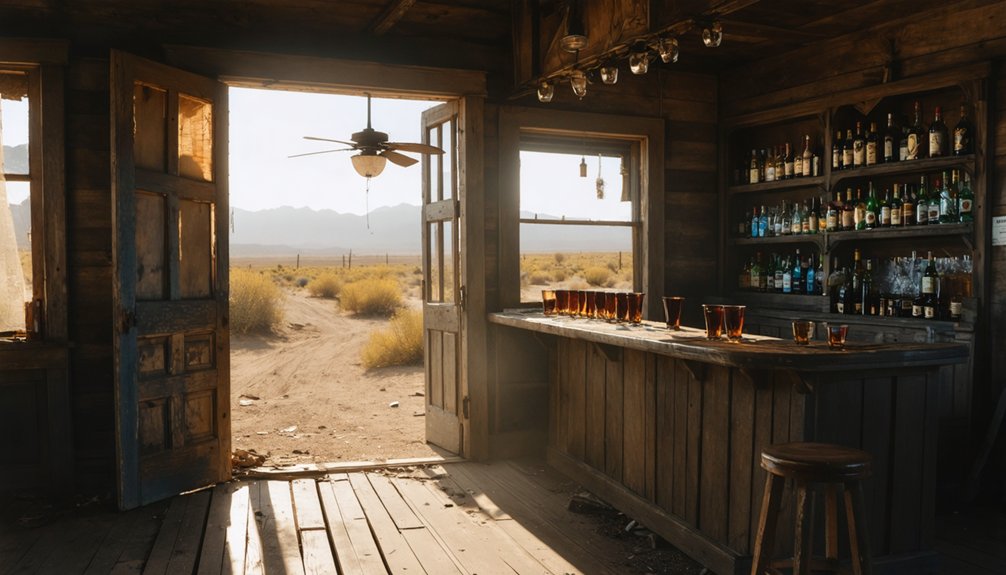Wiskala, once called Whiskey Flat during California’s Gold Rush, emerged as a bustling mining settlement where fortune-seekers established roots. You’ll find its remains near the former Big Blue Mine, which yielded approximately $12 million in gold before operations ceased in 1956. The abandoned town contains fragments of daily life—china dishes, belt buckles, children’s toys—alongside skeletal mining infrastructure. Recent drought has revealed hidden foundations preserving the original 1861 town layout, offering glimpses into frontier life.
Key Takeaways
- Wiskala began as “Whiskey Flat” during the California Gold Rush before becoming a permanent settlement with Native American-derived name.
- The Big Blue Mine yielded $12 million in gold with extensive operations until closing in 1956.
- Daily life centered around mining, with saloons and churches serving as community hubs.
- Economic collapse in the early 1900s led to abandonment as families departed when mining jobs disappeared.
- Artifacts like china fragments and mining equipment remnants preserve Wiskala’s history as a ghost town.
The Origins of Whiskey Flat and Wiskala’s Birth
As the California Gold Rush swept across the Sierra Nevada in the mid-nineteenth century, Whiskey Flat emerged as a rugged frontier settlement catering to fortune-seekers drawn by glittering promises of mineral wealth.
You’d have found this strategic outpost bustling with miners seeking respite in its saloons, where whiskey flowed freely—hence the settlement’s aptly chosen name.
While Whiskey Flat maintained its rough-and-tumble character, Wiskala Origins can be traced to the community’s evolution beyond transient mining camp status.
The settlement adopted this Native American-derived name as residents established more permanent roots. Similar to how Randsburg and Johannesburg transformed from simple mining communities, Wiskala developed schools, churches, and general stores—hallmarks of a maturing community.
This change represented local miners’ aspirations to create stability amidst the boom-and-bust cycle of gold prospecting that defined California’s frontier experience. Like many settlements during the mass migration of early settlers to California, Wiskala exemplifies how communities formed and evolved in response to economic opportunity.
Gold Fever: The Big Blue Mine’s $12 Million Legacy
As you walk the overgrown trails toward the Big Blue Mine, you’re treading upon ground that yielded approximately $12 million in gold during its operational heyday, fueling both Placer County’s economy and the dreams of fortune-seekers who risked everything in its shadowy tunnels.
The mine’s extensive network of shafts and crosscuts, stretching roughly 3,000 feet through river rock deposits and sulfide-rich veins, tells a silent story of technological ambition and human perseverance in the face of flooding, collapse, and eventual abandonment. Situated at an elevation of 3,241 feet above sea level, the Big Blue Mine’s location offered both challenges and advantages to its operators.
While mining companies like Empire Star Mines Company extracted substantial wealth from the Sierra Nevada’s golden veins, the miners themselves often faced grueling conditions for modest compensation, their hopes of striking it rich gradually eroding with each cart of ore that rumbled out from the mountain’s depths.
Fortune Beneath the Mountains
Gold fever, that persistent affliction of fortune-seekers, found perhaps its most dramatic expression in Wiskala’s Big Blue Mine, where Mother Nature concealed a $12 million treasure beneath the rugged Sierra Nevada foothills.
Standing at 3,241 feet elevation, this underground labyrinth witnessed the evolution of gold extraction from humble hand-digging operations to sophisticated mills processing 300 tons daily.
You’d marvel at the mining techniques employed to pursue those gold-bearing quartz veins, some stretching 5 to 12 feet thick.
The mine’s diorite host rock formations provided an ideal environment for the formation of rich gold and scheelite deposits that drew miners to this remote location.
Miners tunneled through river rock and sediment, creating over 3,000 feet of workings to reach the precious ore.
Though initially yielding modest returns—merely $20 from 4,000 tons—the persistence of companies like Burton Brothers ultimately revealed the mountain’s wealth before operations ceased in 1956.
Miners’ Hopes and Despair
When the first prospectors arrived at what would become the Big Blue Mine, they carried more than just picks and shovels—they bore the weight of dreams that would ultimately yield $12 million in precious metals.
You’d find these ambitious souls manually extracting ore, sometimes carrying it down the mountain on their backs, their miners’ aspirations fueled by veins rich with gold and tungsten.
The 3,000-foot tunnels, poorly timbered and chronically flooded, reveal the harsh reality behind their economic struggles.
Despite promising ore bodies—the Big Blue’s 5-foot and Vulture’s 12-foot thick veins—most operations remained small-scale.
By the 1930s, hopes soared with ore yielding 0.35 ounces of gold per ton, but World War II closures ultimately silenced the pick axes.
These miners operated in one of California’s mining districts with distinctive geological features that influenced both their techniques and success rates.
The miners’ dreams, like the abandoned shafts, slowly collapsed under the weight of reality.
Economic Boom and Bust
Though records show some discrepancy in its exact location, the Big Blue Mine stands as a monument to California’s insatiable gold fever, ultimately yielding a remarkable $12 million in precious metals throughout its tumultuous history.
You’d have witnessed dramatic economic cycles as the mine evolved from humble beginnings—where miners hauled ore on their backs—to a sophisticated operation employing 200 workers by the 1930s. Similar to how disambiguation pages clarify multiple locations sharing names like Quartzburg, historical records help distinguish the Big Blue Mine from other mining operations of the era.
The mining impact rippled through local communities as the Tropico Mining Company’s 1909 acquisition sparked development, followed by the Burtons’ expansion in the late 1920s. By 1935, their 300-ton capacity mill processed ore yielding 0.35 ounces of gold per ton.
This prosperity ended abruptly with the 1942 wartime closure order. Despite post-war revival attempts, depleted ore bodies and shifting gold prices sealed the mine’s fate.
Daily Life in a Frontier Mining Community
Mining communities across California’s rugged frontier landscapes operated with a disciplined rhythm that belied their seemingly chaotic exteriors. While specific details about Wiskala remain elusive in historical records, frontier mining settlements throughout the Mother Lode region shared common patterns of existence.
Beneath the dusty disorder of California’s gold camps lay surprising structure—a community’s heartbeat amid wilderness.
You’d rise before dawn, following daily routines that structured life around the relentless pursuit of gold. Community gatherings served as essential social anchors—improvised saloons hosted Saturday night dances, while makeshift churches provided Sunday respite. Working conditions were often dangerous, with miners spending over 10 hours in dark, hot environments deep below the surface. Highway 49, also known as the Golden Chain Highway, connected these historical mining towns and preserved their cultural legacy.
Women maintained domestic order in canvas tents and rough-hewn cabins while men labored in creek beds and mine shafts.
To fully understand Wiskala’s particular character would require deeper archival research, consulting local historical societies and California state records that preserve the authentic voices of these vanished communities.
Saloons, Hotels and Churches: Building a Mining Town

As frontier settlements like Wiskala transformed from temporary encampments into established mining towns, three institutions invariably formed the backbone of community development: saloons, hotels, and churches.
These structures reflected both practical needs and deeper social yearnings among those seeking fortune in California’s rugged terrain. Similar to ghost town remnants across California, these buildings often tell the story of past prosperity and eventual decline.
The architectural and social elements that defined Wiskala’s character included:
- Saloons culture offering more than mere libation—they functioned as communication hubs, financial exchanges, and democratic spaces where class distinctions temporarily dissolved.
- Hotel architecture ranging from crude lodging houses to more sophisticated establishments featuring distinctive Western facades that signaled permanence.
- Church significance extending beyond spiritual matters to provide moral foundation, educational opportunities, and a counterbalance to the mining community’s rougher elements.
Social gatherings at these establishments created the communal bonds necessary for survival and civility.
Law and Disorder: Justice in the Wild West
When Wiskala emerged from the rugged Kern County wilderness, the concept of law and justice remained fluid and adaptable—much like the mercury used in gold processing operations.
You’d rarely spot a sheriff’s deputy in town except during serious disturbances, as Kern County’s law enforcement stretched thin across the vast territory after its 1866 establishment.
In their absence, Wiskala residents often took matters into their own hands. Vigilante justice wasn’t uncommon when thieves targeted mining claims or troublemakers disrupted the fragile social order.
When trouble came to Wiskala, locals dispensed frontier justice swiftly—protecting their claims and community when no badge was in sight.
Trials, when they occurred, happened in makeshift settings—sometimes in the back of Thornton’s Saloon—with local juries delivering swift verdicts influenced by community sentiment.
Punishment could mean fines, jail in the county seat, or simply being escorted to town limits and told never to return.
Native American Conflicts in Kern Valley

As you explore Wiskala’s turbulent history, you’ll find that Tübatulabal and Mono peoples fought desperately to protect their ancestral lands from the gold-seeking settlers who misinterpreted native customs and resource management practices as threats.
Cultural barriers prevented meaningful dialogue, with each side viewing the other through lenses of fear and suspicion that transformed minor disagreements into blood feuds.
The meandering Kern River, once a life-giving artery for indigenous communities, became the backdrop for violent confrontations like the 1863 Keyesville Massacre, where thirty-five native men perished at the hands of U.S. cavalry and local militiamen seeking to assert dominance over the contested valley.
Territorial Disputes Escalate
The intensifying conflict between settlers and indigenous peoples in the Kern Valley during the mid-nineteenth century emerged from a fundamental clash over land rights and resources.
Despite the July 1851 treaty promising 763,000 acres to tribal nations, settlers continuously violated these agreements, claiming hundreds of thousands of acres of traditional lands while introducing livestock that destroyed native food sources.
When you examine the land disputes closely, you’ll find tribal resistance emerged from desperation as their subsistence options vanished:
- Chief Old Jesus of the Kawaiisu developed profound animosity toward settlers who’d forced his people into remote hills.
- Yokuts warriors, facing starvation as wheat fields replaced wilderness, began taking cattle for survival.
- Tübatulabal territory along the Kern River branches steadily diminished as mining operations expanded.
Cultural Misunderstandings Abound
Beyond the territorial disputes that ravaged Wiskala lay a deeper, more insidious conflict—one rooted in profound cultural misunderstandings between settlers and indigenous peoples.
You’d have witnessed the tragic breakdown of potential cultural exchanges as settlers misinterpreted Tübatulabal and Mono gatherings as hostile preparations. Language barriers prevented meaningful dialogue, while complex indigenous social structures were dismissed as primitive.
When you examine historical accounts, you’ll find settlers routinely referred to natives as “savages,” ignoring their own role in disrupting established ways of life.
The Sebastian Reserve at Tejon Pass, established in 1853, embodied this disconnect—aiming to assimilate tribes without respecting their autonomy. Traditional practices like seasonal migration became criminalized, while newspapers exaggerated threats to justify military action.
This fundamental inability to recognize indigenous humanity would ultimately transform Wiskala into the ghost town you can visit today.
Deadly Kern River Battles
Bloody confrontations along the Kern River marked a devastating chapter in Wiskala’s history, transforming once-peaceful waterways into battlegrounds of cultural extinction.
Captain McLaughlin’s campaigns against the Tübatulabal and Mono tribes exemplified the systematic settler aggression that decimated indigenous populations.
As you explore Wiskala’s troubled past, consider these pivotal conflicts:
- The 1863 Keyesville Massacre where 35 Native Americans perished in a dawn attack, despite many having surrendered weapons as a peace gesture.
- Military expeditions led by Captain Kern that killed approximately twenty indigenous people without soldier casualties.
- Retaliatory campaigns following indigenous resistance to cattle theft accusations, often disguising territorial conquest.
The Tübatulabal population collapsed from 1,200 to mere hundreds—scattered survivors of a coordinated effort to eliminate indigenous resistance through surprise attacks and overwhelming force.
The Final Days: Economic Collapse and Abandonment

While prosperity once flowed through Wiskala’s streets like the very rivers that powered its mills, economic collapse struck with devastating precision in the early 1900s.
The town’s fatal flaw was its lack of economic sustainability—entirely dependent on a single industry that depleted its natural resources with voracious speed.
Prosperity dies when communities build upon foundations of unsustainable single-resource extraction.
As jobs vanished, you’d have witnessed families loading sparse belongings into wagons, abandoning homes in a population migration that accelerated during broader economic downturns.
Infrastructure crumbled from neglect, while earthquakes delivered devastating final blows to weakened structures.
The government’s shifting priorities favored urban centers, leaving isolated Wiskala to wither.
The final residents clung to empty streets until even they surrendered to inevitability.
Nature reclaimed what man abandoned, leaving only scattered foundations as silent testimony to Wiskala’s existence.
What Remains: Exploring Wiskala’s Ghost Town Ruins
As you wander through Wiskala’s overgrown pathways, you’ll encounter the skeletal remains of ore processing equipment and collapsed mineshaft entrances that once bustled with industrial activity.
Rusted tools, broken bottles, and faded mercantile signs lie scattered among the stone foundations and weathered wooden facades, offering silent testimony to the daily lives of those who sought fortune in this remote outpost.
The most poignant discoveries often come from examining the personal artifacts—fragments of china dishes, tarnished belt buckles, and children’s toys—that connect you directly to the human stories behind this boom-and-bust California settlement.
Abandoned Mining Structures
The skeletal remains of Wiskala’s mining infrastructure stand as silent sentinels to the town’s once-thriving industry. As you explore these abandoned structures, you’ll encounter massive mine shafts cutting into hillsides, some partially collapsed while others have been sealed for safety concerns.
Rusting ore carts rest eternally on weathered rail tracks, frozen in their final positions when the mines fell silent.
The mining remnants reveal the scale of operations that once dominated this landscape:
- Foundations of compressor houses and blacksmith shops, now roofless and exposed to the elements
- Scattered stamp mills and processing equipment, their metal components slowly surrendering to rust
- Elaborate water systems including reservoirs and ditches that powered hydraulic mining operations
These industrial artifacts offer freedom to wander through time, touching the physical evidence of ambition and industry.
Artifacts Among Ruins
Scattered remnants of daily life wait to be discovered by careful observers wandering through Wiskala’s crumbling structures. As you explore these forgotten spaces, imagine the significance each artifact once held—rusty mining tools that carved fortunes from mountainsides, fragmented bottles that once contained medicine or whiskey, and weathered leather boots abandoned decades ago.
The preservation of these ruins presents a delicate balance between historical documentation and natural reclamation. Each artifact tells a story of prosperity, hardship, and eventual abandonment that defined California’s gold rush era.
When visiting, remember that removing even seemingly insignificant items diminishes the site’s historical integrity. Instead, photograph these treasures in their original context, allowing future explorers to experience Wiskala’s authentic narrative—a reflection of those who sought freedom in these remote mountains before surrendering to time’s inevitable march.
Environmental Changes Revealing Hidden History

When Lake Isabella‘s waters receded to a mere 8% capacity during California’s severe three-year drought, they revealed a remarkable historical treasure that had remained concealed for seven decades.
Whiskey Flat, submerged since the late 1940s, emerged from its watery tomb in September 2022—a symbol of climate impact on our landscape and its historical significance.
As you explore this temporarily accessible ghost town, you’ll notice:
- Virtually unchanged settlement foundations preserving the 1861 town layout
- A distinctive “toilet bowl ring” along the shoreline marking previous water levels
- Original building structures offering physical evidence of 19th-century mining infrastructure
This cyclical submersion pattern demonstrates climate change‘s intensifying extremes.
You’re witnessing California’s “weather whiplash”—where drought reveals what flooding conceals, offering brief windows into our submerged past.
Wiskala’s Place in California’s Gold Rush Narrative
While the drought-revealed foundations of Whiskey Flat offer a tangible glimpse into California’s hidden past, they also tell a broader story within the state’s defining historical chapter.
Wiskala emerged as one of countless mining settlements that transformed California’s landscape during the 1848-1855 Gold Rush. You can trace its importance through the demographic explosion it represented—part of the wave that increased California’s population from 14,000 to over 250,000 in just four years.
The settlement’s miners employed placer mining methods typical of the era, working riverbeds and gravel deposits for precious metal.
Like other Mother Lode settlements, Wiskala’s population reflected the diverse origins of Gold Rush participants—Americans alongside Chinese, Latin American, and European miners—though discriminatory practices often marginalized non-white prospectors in these Sierra Nevada foothills communities.
Frequently Asked Questions
What Happened to Adam Hamilton After Wiskala’s Decline?
You’ll find no historical records of Adam Hamilton’s legacy after Wiskala’s decline. Hamilton’s later ventures remain undocumented in archives—his fate an unexplored chapter in California’s ghost town narratives.
Are There Any Haunting Legends Associated With Wiskala?
You won’t find documented ghostly sightings or haunted tales specifically linked to Wiskala. Unlike neighboring ghost towns with rich paranormal folklore, Wiskala’s spectral history remains conspicuously silent in historical records.
Did Any Notable Historical Figures Visit Wiskala?
While bustling mining towns attracted famous visitors, Wiskala’s quiet indigenous settlement didn’t draw notable figures. You won’t find any historical significance tied to celebrity appearances in this freedom-loving community’s sparse records.
Can Tourists Legally Collect Artifacts From Wiskala Today?
No, you can’t legally collect artifacts from this historic site. Strict legal restrictions protect these remnants of the past, preserving the authentic narrative that artifact collection would otherwise diminish forever.
How Did Mining Techniques Evolve Throughout Wiskala’s Operational History?
Like a phoenix rising from desert dust, you’d observe Wiskala’s evolution from basic dry placer techniques to sophisticated hard rock mining, with revolutionary gold extraction methods and technological advancements including Huntington mills and mercury processing.
References
- https://www.sfgate.com/centralcoast/article/lake-isabella-ghost-town-emerges-17415393.php
- https://www.youtube.com/watch?v=B1-bQ33BGr0
- https://californialocal.com/localnews/statewide/ca/article/show/51711-10-california-ghost-towns-to-see/
- https://www.youtube.com/watch?v=OD9M6MP6RRU
- https://dornsife.usc.edu/magazine/echoes-in-the-dust/
- https://www.flyingdawnmarie.com/new-blog/silver-city-ghost-town
- https://www.visitcalifornia.com/road-trips/ghost-towns/
- https://en.wikipedia.org/wiki/List_of_ghost_towns_in_California
- https://www.youtube.com/watch?v=ElbXVNDurPc
- https://whimsysoul.com/must-see-california-ghost-towns-explore-forgotten-histories/



